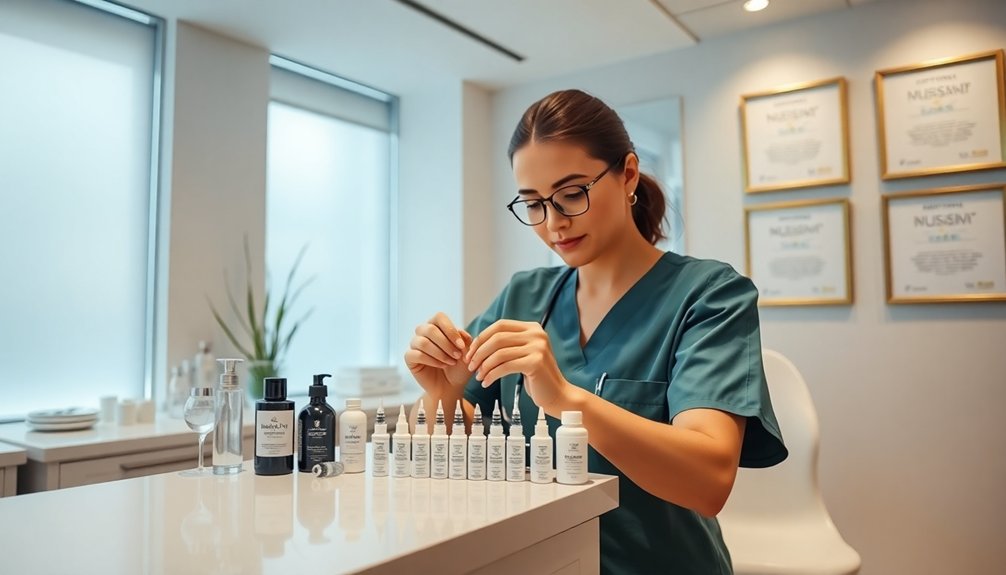To become Botox certified as an RN, you’ll need a valid nursing license, relevant clinical experience, and completion of an accredited training program.
Start by researching your state’s specific requirements and selecting a reputable certification course that includes hands-on practice with live patients.
You’ll learn facial anatomy, injection techniques, and safety protocols during your training.
After certification, secure proper insurance coverage and establish your practice.
This overview covers the basics, but there’s much more to master in aesthetic medicine.

Summary
- Verify current RN license status and complete minimum 1-2 years of clinical experience before pursuing Botox certification.
- Research and select an accredited training program that offers comprehensive hands-on experience with live patients.
- Complete a state-approved Botox certification course focusing on facial anatomy, injection techniques, and safety protocols.
- Gain supervised clinical practice under licensed providers while mastering proper injection techniques and patient assessment.
- Obtain necessary insurance coverage and maintain continuing education credits to stay compliant with state regulations.
Understanding Prerequisites and Basic Requirements
Before pursuing Botox certification, registered nurses must meet several foundational requirements to qualify for training.
The basic Botox prerequisites for RNs include:
- Valid RN license in good standing
- Minimum of an associate’s or bachelor’s degree in nursing
- Relevant medical experience in a clinical setting
RN eligibility requirements focus on your professional credentials and education.
You’ll need to:
- Submit proof of your nursing degree
- Provide current license documentation
- Demonstrate clinical experience
- Choose an accredited training program
These requirements guarantee you have the foundational medical knowledge needed to safely administer Botox treatments and maintain professional standards.
Researching State-Specific Regulations and Guidelines
Since state regulations for Botox administration vary considerably across the U.S., you’ll need to research your specific state’s requirements carefully.
Pay close attention to state licensing requirements and supervision rules, which can change frequently.
Key areas to research:
- Training program accreditation requirements
- Physician supervision guidelines
- Face-to-face consultation mandates
- On-site presence requirements
Stay current with regulatory updates in your state, as guidelines can change.
For example, Texas requires on-site physician presence, while New York mandates specific supervision protocols.
Contact your state’s medical licensing board directly to confirm current requirements and avoid potential legal issues.
Selecting an Accredited Training Program
When choosing a Botox certification program, you’ll need to verify the program’s accreditation status and compliance with your state’s regulations.
You’ll want to focus on programs that offer substantial hands-on training with live patients under expert supervision, as practical experience is essential for developing proper injection techniques.
The program’s cost and time commitment should fit your budget and schedule, though it’s important not to compromise on quality for these factors.
Program Accreditation Requirements
Selecting an accredited training program represents an essential first step in your journey toward Botox certification.
When choosing a program, you’ll need to verify it meets state regulatory requirements and industry standards.
| Requirements | Benefits |
|---|---|
| State Recognition | Legal Protection |
| Expert Faculty | Professional Growth |
| Hands-on Training | Enhanced Skills |
| Updated Curriculum | Patient Safety |
Look for programs accredited by respected organizations like the American Academy of Facial Esthetics.
The accreditation benefits include thorough training and legal compliance, while program standards guarantee you’ll receive instruction from experienced practitioners.
Your chosen program should offer hands-on experience with live patients or models, plus coverage of facial anatomy and injection techniques.
Hands-On Training Components
A robust hands-on training component stands at the core of any quality Botox certification program.
You’ll receive clinical practice in small groups within medical spa settings, working directly with experienced instructors who are board-certified professionals.
Your hands-on training includes working with both simulation models and live patients, ensuring you develop practical injection skills under expert supervision.
You’ll learn proper techniques while building confidence in a controlled environment.
- Master precise injection techniques through guided practice
- Gain real-world experience with actual patients
- Develop confidence through expert mentorship
- Perfect your skills in specialized facial areas
These clinical components prepare you for safe, effective Botox administration in your future practice.
Cost and Time Investment
Making a smart investment in your Botox certification requires careful consideration of both cost and time commitments.
The cost breakdown typically ranges from $3,000 to $6,000, varying by location and program quality.
You’ll find competitive pricing options across different institutions, with specific costs listed on course landing pages.
Training duration usually spans 1 to 3 days, designed to accommodate busy healthcare professionals.
These intensive programs deliver:
- Thorough theoretical knowledge
- Hands-on practical experience
- Safety protocol training
- Live patient practice opportunities
Programs maintain efficiency without compromising quality, allowing you to start practicing immediately after certification.
Completing Facial Anatomy and Injection Training
To effectively administer Botox treatments, you’ll need a thorough understanding of facial muscle groups and their interactions with surrounding structures.
You’ll learn to map out safe injection sites by identifying key anatomical landmarks and avoiding critical blood vessels and nerves.
The hands-on portion of your training will focus on proper injection techniques, including ideal angles, depths, and dosing for each treatment area.
Understanding Muscle Groups
Successful Botox treatments depend on mastering the complex network of facial muscles and their interactions.
You’ll need to understand how muscles work together to create facial expressions and how they respond to treatment.
Key muscle groups include the frontalis for forehead movement, glabellar complex for frowning, and orbicularis oculi for eye expressions.
- Master the frontalis muscle to prevent unwanted brow drooping
- Learn the glabellar complex to effectively treat frown lines
- Study the orbicularis oculi for precise crow’s feet treatment
- Understand the nasalis muscle to properly address bunny lines
These muscle groups require precise knowledge of their functions, nerve connections, and potential treatment impacts.
Your expertise in muscle interactions will directly affect treatment outcomes.
Safe Injection Site Mapping
Safe injection site mapping builds directly on your muscle group knowledge by focusing on precise placement and risk avoidance.
You’ll learn to identify critical areas where safe injection techniques are essential for patient safety.
Key mapping considerations include:
- Avoiding major blood vessels and the ophthalmic artery
- Maintaining distance from the upper orbital bone
- Using red or black ink to mark precise injection sites
- Evaluating facial expressions for best placement
During pre-treatment mapping:
- Have patients make various expressions
- Document contraindications
- Mark safe zones away from high-risk areas
- Identify muscle boundaries for proper dosing
- Assess skin quality at injection sites
Practical Application Techniques
Mastering practical application techniques marks a critical milestone in your Botox certification journey.
You’ll learn muscle anatomy applications while practicing proper injection techniques on anatomical models.
Understanding facial muscle functions and their interactions helps you deliver precise treatments.
- Map injection sites based on individual muscle mass and structure
- Practice proper dosage calculations for different facial areas
- Master various injection angles and depths for ideal results
- Learn to identify and avoid critical vascular structures
Through hands-on training, you’ll develop confidence in administering treatments safely.
Focus on mastering the fundamentals of practical injection techniques before advancing to more complex procedures.
Your training should emphasize both technical precision and patient safety considerations.
Gaining Hands-On Clinical Experience
Gaining real-world experience with Botox injections requires a structured approach and careful adherence to clinical requirements.
You’ll need to complete supervised training under licensed providers while practicing hands-on techniques in a clinical setting.
| Requirement | Duration | Details |
|---|---|---|
| RN License | Current | Must be in good standing |
| Medical Experience | 1-2 years | Clinical setting required |
| Supervised Training | Varies | Under licensed provider |
During your clinical experience, you’ll need valid orders for each procedure and can’t make independent decisions about medication dosages.
Focus on patient assessment, proper injection techniques, and follow-up care while maintaining strict infection control standards.
Obtaining Necessary Certifications and Insurance
Before administering Botox treatments, you’ll need to obtain proper certifications and insurance coverage that meet state requirements.
The certification process involves completing an accredited training program and passing required exams.
You’ll also need extensive insurance options that include both professional and general liability coverage.
- Research state-specific regulations to ascertain your training program meets local requirements
- Complete a 1-2 week certification course covering facial anatomy and safety protocols
- Secure insurance that protects against potential claims and lawsuits
- Maintain continuous education credits to stay current with treatment protocols
Remember to verify that your insurance policy covers both Botox and dermal filler procedures, and obtain proper documentation for your rental space if applicable.
Keep all consent forms and medical history records as required by your insurance provider.
Establishing Your Medical Aesthetic Practice
The success of your medical aesthetic practice depends heavily on creating a robust business foundation and marketing presence.
To drive client acquisition, focus on developing a strong online presence through a well-designed website, engaging social media content, and compelling before-and-after photos.
Implement effective marketing strategies by:
- Analyzing performance metrics to guide decision-making
- Defining your target audience precisely
- Creating consistent content across platforms
- Utilizing clinic management software
- Developing automated communication systems
Enhance client engagement through:
- Strategic email marketing campaigns
- Referral reward programs
- Regular social media updates
- Client testimonial collection
- Performance tracking and adjustments
FAQs
How Long Does It Typically Take for Botox Results to Show?
Your Botox timeline typically follows a predictable pattern.
You’ll notice initial results within 24-48 hours, but don’t expect immediate changes.
The most noticeable improvements appear between days 3-5 as muscles begin relaxing.
Results duration reaches its peak at 14 days, when you’ll see the full effects.
Your provider will schedule a follow-up appointment around this two-week mark to assess your results.
What Is the Average Salary Range for Botox-Certified RNS?
As a Botox-certified RN, you can expect varied salary ranges based on several factors:
Base Salary Range:
- You’ll typically earn $25-40 per hour nationally
- Annual earnings range from $47,000 to $136,000
- The national average is $80,321
Location Impacts:
- Major cities like NYC or LA offer up to $60/hour
- Rural areas average $25-35/hour
Your earnings can increase with:
- Additional certifications
- Years of experience
- Working in high-end clinics or medical spas
Can Pregnant Nurses Administer Botox Treatments to Patients?
While 85% of healthcare facilities allow pregnant nurses to continue most nursing duties, administering Botox requires special consideration.
Due to pregnancy considerations and nursing ethics, it’s recommended that you avoid administering Botox while pregnant.
Though there’s no direct evidence of harm, healthcare providers suggest taking precautionary measures to protect both you and your developing baby.
You can still perform other nursing duties, but it’s best to delegate Botox treatments to non-pregnant colleagues during your pregnancy.
How Often Do Botox-Certified Nurses Need to Renew Their Certification?
The certification frequency for Botox-certified nurses varies by organization.
You’ll need to complete your renewal process according to these common timeframes:
- CANS certification requires renewal every 2 years
- ANCC certifications need renewal every 5 years
- Other aesthetic nursing certifications typically renew every 2-5 years
You’ll need to track your specific renewal dates and complete required continuing education hours to maintain your certification.
Remember to submit your renewal documentation before the deadline to stay certified.
Are There Age Restrictions for Patients Receiving Botox Treatments?
Like a gate that opens at specific times, Botox treatments have clear age guidelines.
Patient eligibility primarily depends on age and medical needs.
You’ll need to be at least 18 years old for cosmetic Botox treatments, as per FDA regulations.
However, if you’re 12 or older, you may receive Botox for specific medical conditions like eyelid spasms.
There’s no upper age limit, but you’ll need to complete a Botox consent form regardless of your age.
Final Thoughts
Your journey to becoming a Botox-certified RN doesn’t end with certification – it’s just the beginning.
You’ll discover new techniques, build a loyal client base, and transform lives through aesthetic medicine.
As you advance your skills and grow your practice, you’re joining an elite group of medical professionals.
The aesthetic medicine field continues to evolve, and you’re now positioned to be at its forefront.




